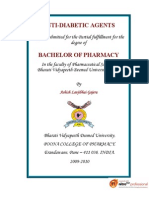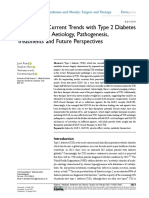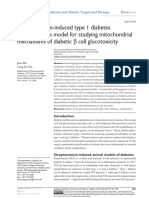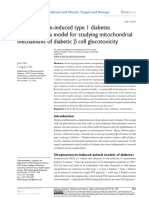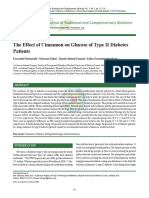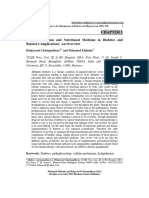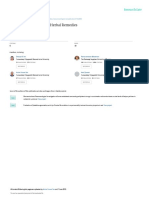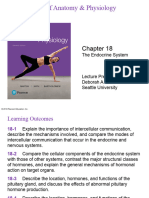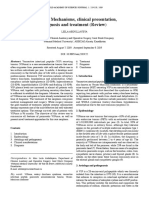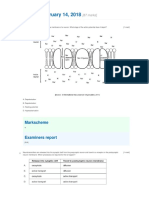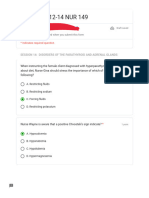dilshad khan (diabetes mellitus)
dilshad khan (diabetes mellitus)
Uploaded by
mayur8052mCopyright:
Available Formats
dilshad khan (diabetes mellitus)
dilshad khan (diabetes mellitus)
Uploaded by
mayur8052mCopyright
Available Formats
Share this document
Did you find this document useful?
Is this content inappropriate?
Copyright:
Available Formats
dilshad khan (diabetes mellitus)
dilshad khan (diabetes mellitus)
Uploaded by
mayur8052mCopyright:
Available Formats
1
BBS INSTITUTE OF PHARMACEUTICAL & ALLIED SCIENCES
GREATER NOIDA
A
Practice SchoolProject Report on
ROLE OF PHYTOMEDICINE IN THE TREATMENT OF
DIABETES
Submitted for Partial Fulfilment of Award of
BACHELOR OF PHARMACY
By
MOHD DILSHAD KHAN
(ROLL NO- 2002950500030)
Under the Guidance of
Assistant Professor Ms. Pratibha Yadav
DR.APJABDUL KALAM TECHNICAL UNIVERSITY
LUCKNOW,UTTAR PARDESH
2023-24
BBS INSTITUTE OF PHARMACEUTICAL AND ALLIED SCIENCES,
GREATER NOIDA, U.P.
2
ACKNOWLEDGEMENT
It is golden opportunity and pleasure for me to acknowledge that
Assistant Professor Ms. Pratibha Yadav. under whom I have started my
project under a control and knowledgeable guidance.
I want to thank Assistant Professor Ms. Pratibha Yadav, BBS Institute of
Pharmaceutical & Allied Sciences, Greater Noida for her inestimable guidance,
valuable suggestion and constant during the course of his study.
I am thankful to Dr. Naushad Alam (Director), BBS Institute of
Pharmaceutical & Allied Sciences, Greater Noida for their constant moral
support, direction and selfless support throughout the investigation.
I am also grateful to all my faculty members for their guidance during the
project work.
I would like to also thank to my classmate who give moral support &
encouragement to complete my entire study for my project report.
I am indebted infinitely to care, support and trust being shown by my parents
without whom it would not be possible to complete this project.
BBS INSTITUTE OF PHARMACEUTICAL AND ALLIED SCIENCES,
GREATER NOIDA, U.P.
3
CERTIFICATE
The work described in this thesis entitled “ROLE OF PHYTOMEDICINE IN
THE TREATMENT OF DIABETES” has been carried out by
MOHD DILSHAD KHAN under my supervision. I certify that the work
described is original and has not been submitted for any degree to this or any
other university.
Date:
Place: Greater Noida
Submitted to:
Assistant Professor Ms. Pratibha Yadav,
BBS Institute of Pharmaceutical& Allied Sciences, Greater Noida
BBS INSTITUTE OF PHARMACEUTICAL AND ALLIED SCIENCES,
GREATER NOIDA, U.P.
4
DECLARATION
I MOHD DILSHAD KHAN hereby declare that submission of my training
report and that is to the best of my knowledge and belief, it contains no material
previously published or written by any other person nor material which to a
substantial extent has been accepted for the award of any other degree or
diploma of the university or other institute of higher learning, except where due
acknowledgment has been made in the text.
Name: MOHD DILSHAD KHAN
Roll No: 2002950500030
BBS INSTITUTE OF PHARMACEUTICAL AND ALLIED SCIENCES,
GREATER NOIDA, U.P.
5
TABLE OF CONTENT
S. No. Name of Topic Page No.
1. Abstract 6
2. Introduction 7-9
3. Brief Description 10-18
4. Future prospective 19-22
5. Summary & Conclusion 23-24
6. Bibliography 25-26
7. Reference 27-30
BBS INSTITUTE OF PHARMACEUTICAL AND ALLIED SCIENCES,
GREATER NOIDA, U.P.
6
ABSTRACT
Diabetes mellitus (DM), both insulin-dependent DM (IDDM) andnon-insulin
dependent DM (NIDDM) is a common and serious metabolic
disorderthroughout the world. Traditional plant treatments have been used
throughout theworld for the therapy of diabetes mellitus. Among many
medications and otheralternative medicines, several herbs have been known to
cure and control diabetes;additionally they have no side effects. The present
paper is an attempt to list of theplants with anti-diabetic and related beneficial
effects originating from differentparts of world. History showed that medicinal
plants have been used in traditionalhealing around the world for a long time to
treat diabetes; this is because such herbalplants have hypoglycemic properties
and other beneficial properties, as reported inscientific literature. The medicinal
plants, besides having natural therapeutic valuesagainst various diseases and
considerable works have been done on these plants totreat diabetes mellitus,
describes that the antidiabetic activity of medicinal plants isdue to the presence
of phenolic compounds, flavonoids, terpenoids, coumarins andother constituents
which show reduction in blood glucose levels. Some of theseherbal plants and
their active chemical constituents which have a role in themanagement of
diabetes mellitus are compiled here and discussed in this review.
BBS INSTITUTE OF PHARMACEUTICAL AND ALLIED SCIENCES,
GREATER NOIDA, U.P.
7
CHAPTER 1
INTRODUCTION
INTRODUCTION
BBS INSTITUTE OF PHARMACEUTICAL AND ALLIED SCIENCES,
GREATER NOIDA, U.P.
8
Diabetes mellitus is a groupof metabolic diseases characterized by high bloodsugar (glucose)
levels that result from defects ininsulin secretion, or action, or both. Diabetesmellitus,
commonly referred to as diabetes (as itwill be in this article) was first identified as adisease
associated with "sweet urine," andexcessive muscle loss in the ancient world.
Elevated levels of blood glucose (hyperglycemia)lead to spillage of glucose into the urine,
hence theterm sweet urine.Normally, blood glucose levels are tightlycontrolled by insulin, a
hormone produced by thepancreas. Insulin lowers the blood glucose level.When the blood
glucose elevates (for example,after eating food), insulin is released from thepancreas to
normalize the glucose level. In patientswith diabetes, the absence or insufficientproduction of
insulin causes hyperglycemia.Diabetes is a chronic medical condition, meaningthat although
it can be controlled, it lasts alifetime.
Category of a Fasting Value Post Prandial
person
Minimum Maximum Value Value 2 hours after consuming glucose
Value
Normal 70 -100 Less than 140
Early 101 -126 140 to 200
Diabetes
Established Diabetes More than – 126 More than 200
BBS INSTITUTE OF PHARMACEUTICAL AND ALLIED SCIENCES,
GREATER NOIDA, U.P.
9
BBS INSTITUTE OF PHARMACEUTICAL AND ALLIED SCIENCES,
GREATER NOIDA, U.P.
10
CHAPTER 2
BRIEF
DESCRIPTION
BBS INSTITUTE OF PHARMACEUTICAL AND ALLIED SCIENCES,
GREATER NOIDA, U.P.
11
Diabetes mellitus is a group of metabolic diseases characterized by high blood sugar
(glucose) levels that result from defects in insulin secretion, or action, or both. Diabetes
mellitus, commonly referred to as diabetes (as it will be in this article) was first identified as a
disease associated with "sweet urine," and excessive muscle loss in he ancient world.
Elevated levels of blood glucose (hyperglycemia) lead to spillage of glucose into the urine,
hence the term sweet urine. Normally, blood glucose levels are tightly controlled by insulin, a
hormone produced by the pancreas. Insulin lowers the blood glucose level. When the blood
glucose elevates (for example, after eating food), insulin is released from the pancreas to
normalize the glucose level. In patients with diabetes, the absence or insufficient production
of insulin causes hyperglycemia. Diabetes is a chronic medical condition, meaning that
although it can be controlled, it lasts a lifetime.
Phytomedicine, or the use of plant-derived compounds for medicinal purposes, has gained
attention in the treatment of diabetes due to the potential therapeutic properties of certain
plants. Here is a brief description of the role of phytomedicine in the treatment of diabetes:
Blood Glucose Regulation: Some plant compounds have demonstrated the ability to
regulate blood glucose levels. These compounds may act by enhancing insulin sensitivity,
promoting glucose uptake by cells, and inhibiting enzymes that break down carbohydrates,
thus contributing to better glycemic control.
BBS INSTITUTE OF PHARMACEUTICAL AND ALLIED SCIENCES,
GREATER NOIDA, U.P.
12
Insulin Sensitization: Phytomedicine may improve insulin sensitivity, which is often
impaired in conditions like type 2 diabetes. Certain plant-derived compounds can enhance
the effectiveness of insulin, leading to better utilization of glucose by cells and a reduction
in insulin resistance.
Beta-Cell Protection: Diabetes is characterized by dysfunction or loss of insulin-
producing beta cells in the pancreas. Some plant compounds exhibit protective effects on
these cells, helping to preserve their function and potentially preventing the progression of
the disease.
Antioxidant Properties: Oxidative stress and inflammation play roles in diabetes and its
complications. Many plants contain antioxidants that can neutralize free radicals and
reduce oxidative damage, thereby mitigating the impact of these processes on insulin
signaling and overall health.
Complication Prevention: Phytomedicine may contribute to the prevention of diabetes-
related complications such as cardiovascular disease, neuropathy, and nephropathy.
Certain plant compounds have shown potential in protecting vital organs and tissues from
the harmful effects of chronic hyperglycemia.
Natural Alternative or Adjunctive Therapy: Some individuals seek natural alternatives
or complementary therapies to manage diabetes, either alongside conventional
medications or as standalone treatments. Phytomedicine offers a potential avenue for those
looking for alternative or adjunctive approaches to diabetes management.
Dietary Supplements: Plant-based supplements, such as herbal extracts and botanical
formulations, are commonly used in traditional medicine systems. These supplements may
contain bioactive compounds that exert beneficial effects on various aspects of diabetes
management.
BBS INSTITUTE OF PHARMACEUTICAL AND ALLIED SCIENCES,
GREATER NOIDA, U.P.
13
Research and Development: Ongoing research is exploring the identification of novel
plant compounds and formulations with anti-diabetic properties. This includes
investigating the mechanisms of action, safety profiles, and potential synergies with
existing diabetes medications.
While phytomedicine holds promise in the treatment of diabetes, it's important to approach
its use with caution. Patients should consult healthcare professionals before incorporating
plant-based therapies into their diabetes management plan, especially if they are already
taking prescribed medications. Additionally, rigorous scientific research and clinical trials
are essential to establish the efficacy and safety of specific phytomedicinal interventions
for diabetes.
Causes of Diabetes
Insufficient production of insulin (either absolutely or relative to the body's needs),
production of defective insulin (which is uncommon), or the inability of cells to use
insulin properly and efficiently leads to hyperglycemia and diabetes. This latter condition
affects mostly the cells of muscle and fat tissues, and results in a condition known as
"insulin resistance." This is the primary problem in type 2 diabetes.
The absolute lack of insulin, usually secondary to a destructive process affecting the
insulin producing beta cells in the pancreas, is the main disorder in type 1diabetes. In type
2 diabetes, there also is a steady decline of beta cells that adds to the process of elevated
blood sugars. Essentially, if someone is resistant to insulin, the body can, to some degree,
increase production of insulin and overcome the level of resistance. After time, if
production decreases and insulin cannot be released as vigorously, hyperglycemia
develops.
Glucose is a simple sugar found in food. Glucose is an essential nutrient that provides
energy for the proper functioning of the body cells. Carbohydrates are broken down in the
small intestine and the glucose in digested food is then absorbed by theintestinal cells into
the bloodstream, and is carried by the bloodstream to all the cells in the body where it is
utilized. However, glucose cannot enter the cells alone and needs insulin to aid in its
transport into the cells. Without insulin, the cells become starved of glucose energy
despite the presence of abundant glucose in the blood stream. In certain types of diabetes,
the cells' inability to utilize glucose gives rise to the ironic situation of "starvation in the
midst of plenty". The abundant, unutilized glucose is wastefully excreted in the
BBS INSTITUTE OF PHARMACEUTICAL AND ALLIED SCIENCES,
GREATER NOIDA, U.P.
14
urine.Insulin is a hormone that is produced by specialized cells (beta cells) of the pancreas.
(The pancreas is a deep-seated organ in the abdomen located behind the stomach.) In
addition to helping glucose enter the cells, insulin is also important in tightly regulating
the level of glucose in the blood. After a meal, the blood glucose level rises.
In response to the increased glucose level, the pancreas normally releases more insulin
into the bloodstream to help glucose enter the cells and lower blood glucose levels after a
meal. When the blood glucose levels are lowered, the insulin release from the pancreas is
turned down. It is important to note that even in the fasting state there is a low steady
release of insulin than fluctuates a bit and helps to maintain a steady blood sugar level
during fasting. In normal individuals, such a regulatory system helps to keep blood
glucose levels in a tightly controlled range. As outlined above, in patients with diabetes,
the insulin is either absent, relatively insufficient for the body's needs, or not used properly
by the body.All of these factors cause elevated levels of blood glucose (hyperglycemia).
Herbal Treatment of Diabetes Mellitus
1. BITTER MELON
Biological source: It is obtained from edible fruit of Momordica charantia, belonging to
the family Cucurbitaceae.
Chemical constituents:
The plant contains several biologically active compounds-
Chiefly momordicin I &momordicin II, cucurbitacin B
Glycosides (momordin, charantin, charantosides, goyaglycosides)
Terpenoid compounds- momordicinin, momordicilin, momordol
Cytotoxic (ribosome inactivating) proteins such as momorcharin&momordin.
BBS INSTITUTE OF PHARMACEUTICAL AND ALLIED SCIENCES,
GREATER NOIDA, U.P.
15
Uses: Bitter melon is used as anti-diabetic. It contains lectin that has insulin like activity
due toits non- protein specific linking together to insulin receptors. This lectin lowers
blood glucose level by acting on peripheral tissues. Lectin is a major contributor to
hypoglycemic effect.
Scientific work done- Triterpenoids Isolated from Bitter Melon has showed antidiabetic
activity.
2. FIERY COSTUS
Biological Source: It is obtained from the leaves of the plant Costusigneus, belonging to
the family Costaceae.
Chemical Constituents:
The main chemical constituents are Beta-carotene, deoxyribose, phenol, flavonoids, and
insulin precursors.
Uses: The leaves of insulin plant reduced the fasting and postprandial blood sugar levels,
bringing them down towards normal. Reduction in the fasting and the postprandial blood
sugar levels with leaves of insulin plant was comparable with that obtained with
Glibenclamide 500 µg/kg at 250 mg/kg/day and 500 mg/kg/day of powdered leaves of the
insulin plant.
The hypoglycemic action can be due to release of insulin, insulin-sensitizing action or a
combination of both. Hence further studies need to be undertaken to determine the
mechanism of action by measurement of either insulin or 'C' peptide level.
BBS INSTITUTE OF PHARMACEUTICAL AND ALLIED SCIENCES,
GREATER NOIDA, U.P.
16
Scientific work done: Costusigneus has showed effect on hyperglycemia.7
Dosage Forms: It is used as oral hypoglycemic agent, or as i.v. injection.
Dose: Tablet- 1 tablet/ day.
3. DANDELION
Biological Source :It is obtained from the leaves of Taraxacum officinale, belonging to
the family Asteraceae.
Chemical Constituents:
Sesquiterpene lactones (bitters): taraxinic acid (taraxacin), tetrahydroridentin B
Triterpenoids and sterols: taraxasterol, taraxerol, cycloartenol, beta-
sitosterol
Other: Vitamin A, Vitamin C, tannins, alkaloids, pectin, inulin, starch, potassium, beta
carotene, caffeic acid, flavonoids (apigenin)8
Uses: It is a good antidiabetic drug. It can lower the blood glucose level .Tests on diabetic
mice show that dandelion extract may help regulate blood sugar and keep cholesterol in
check.9 Scientific work done:
Dandelion has showed antihyperglycemic effect.
4. FRENCH LILAC
BBS INSTITUTE OF PHARMACEUTICAL AND ALLIED SCIENCES,
GREATER NOIDA, U.P.
17
Biological Source: It consists of the aerial parts of the plant, flowers, leaf, stem, seeds of
the plant Galega officinalis, belonging to the family Fabaceae.
Chemical Constituents:
Oleanane &ursane type triterpinoids like sophoradiol, soyasapogenol b, & 9-sitosterol,
Sophorediol, galactogil, galegine, peganine, hydroxygalegine, vasicinone, alkaloids like
lutein,pentahydroxyflavone 5 glucoside, luteoline, galuteoline, luteoline 5
glucosides,flavonoids, saponines etc.11
Uses: It has been known since the Middle Ages for relieving the symptoms of diabetes
mellitus.
And many more like GULVEL, TURMERIC, GURMAR, BAEL, FENUGREEK,
AMLA, INDIAN KINO TREE, NAYANTARA, CINNAMON, NEEM,
SAPTARANGI, ONION, GARLIC, etc are used in the treatment of diabetes mellitus.
BBS INSTITUTE OF PHARMACEUTICAL AND ALLIED SCIENCES,
GREATER NOIDA, U.P.
18
BBS INSTITUTE OF PHARMACEUTICAL AND ALLIED SCIENCES,
GREATER NOIDA, U.P.
19
CHAPTER 3
FUTURE
PROSPECTIVE
FUTURE PROSPECTIVE
BBS INSTITUTE OF PHARMACEUTICAL AND ALLIED SCIENCES,
GREATER NOIDA, U.P.
20
Phytomedicine, which involves the use of plant extracts and natural products for medicinal
purposes, has been an area of growing interest in the treatment of various health conditions,
including diabetes. However, it's important to note that advancements in research and
medical knowledge may have occurred since then. Here are some potential future prospects
for the role of phytomedicine in the treatment of diabetes:
1. Anti-diabetic Properties: Many plant-derived compounds have shown promising
anti-diabetic properties. These compounds may help regulate blood glucose levels, improve
insulin sensitivity, and reduce complications associated with diabetes.
2. Natural Antioxidants: Oxidative stress plays a significant role in the development
and progression of diabetes and its complications. Some plant compounds possess strong
antioxidant properties, which may help counteract oxidative stress and inflammation
associated with diabetes.
3. Beta-Cell Protection and Regeneration: Diabetes often involves dysfunction or
loss of insulin-producing beta cells in the pancreas. Research is ongoing to identify plant
compounds that can protect these cells from damage or stimulate their regeneration,
potentially restoring proper insulin production.
4. Improving Insulin Sensitivity: Certain plant compounds may enhance insulin
sensitivity, making cells more responsive to insulin's actions. This could be beneficial for
individuals with insulin resistance, a common feature of type 2 diabetes.
5. Reducing Diabetes-Related Complications: Phytomedicine may contribute to
reducing the risk of diabetes-related complications, such as cardiovascular disease,
neuropathy, and nephropathy. Some plant compounds have shown potential in protecting
organs and tissues from the damaging effects of diabetes.
6. Combination Therapies: Future research may explore the integration of
phytomedicine with conventional diabetes medications to enhance overall treatment
BBS INSTITUTE OF PHARMACEUTICAL AND ALLIED SCIENCES,
GREATER NOIDA, U.P.
21
effectiveness. Combining plant-derived compounds with existing medications could
potentially lead to better glycemic control and fewer side effects.
7. Personalized Medicine Approaches: Advances in understanding individual
variations in response to treatment may lead to personalized approaches in phytomedicine for
diabetes. Tailoring treatments based on a person's genetic makeup, lifestyle, and specific
health conditions could optimize therapeutic outcomes.
8. Clinical Trials and Evidence-Based Medicine: Ongoing and future clinical trials
will provide more robust evidence regarding the efficacy and safety of phytomedicine in
diabetes treatment. As more research is conducted, the integration of plant-based therapies
into mainstream medical practices may become more common.
It's crucial to stay updated with the latest scientific literature and consult healthcare
professionals for the most recent information on the role of phytomedicine in the treatment of
diabetes. Always remember that while plant-based therapies may offer potential benefits,
they should be used under the guidance of qualified healthcare providers, especially for
individuals with diabetes who are already on prescribed medications.
BBS INSTITUTE OF PHARMACEUTICAL AND ALLIED SCIENCES,
GREATER NOIDA, U.P.
22
BBS INSTITUTE OF PHARMACEUTICAL AND ALLIED SCIENCES,
GREATER NOIDA, U.P.
23
CHAPTER 4
SUMMARY AND
CONCLUSION
SUMMARY AND CONCLUSION
Diabetes is the most common endocrine disorder that affects nearly 100 million people
worldwide. India, also known as the diabetes capital of the world has witnessed an alarming
increase in the number of diabetics over the past decade. Advancement in modern medicine
has resulted in the development of several pharmaceutical drugs such as biguanides,
BBS INSTITUTE OF PHARMACEUTICAL AND ALLIED SCIENCES,
GREATER NOIDA, U.P.
24
thiazolidinediones, biguanides, and insulin. Even though these drugs show hypoglycemic
activities, they are often associated with several complications such as nephrological
disorders, fatigue, upset stomach, diarrhea, etc. All these reasons have stimulated the rework
on herbal medicine to fine suitable alternatives that will have lesser side effects and improved
therapeutic effects. The present review has summarized the list of medicinal plants of Asian
countries that are known to possess anti-diabetic properties. These plants are traditionally
used by various tribal people for the treatment of several ailments. Pharmacological studies
have reported their hypoglycemic, anti-hyperglycemic, insulin mimicking, anti-lipidemic
properties and hence when administered in proper dosages can be beneficial for ameliorating
the various complications associated with diabetes mellitus. This review provides the scope
for the readers to further explore the active constituents of anti-diabetic plants and its possible
mechanisms for future research.
BBS INSTITUTE OF PHARMACEUTICAL AND ALLIED SCIENCES,
GREATER NOIDA, U.P.
25
BIBLIOGRAPHY
BIBLIOGRAPHY
I am MOHD DILSHAD KHAN ; a student of B. PHARM 4th Year. I have
done this project with the help of my parents, subject teacher, and friends.
I used:-
• MS Word
• Internet Explorer
• Sites
BBS INSTITUTE OF PHARMACEUTICAL AND ALLIED SCIENCES,
GREATER NOIDA, U.P.
26
• Websites like Google, Google scholar, Chrome, Wikipedia
• YouTube
For finalizing this project.
BBS INSTITUTE OF PHARMACEUTICAL AND ALLIED SCIENCES,
GREATER NOIDA, U.P.
27
REFERENCE
REFERENCE
BBS INSTITUTE OF PHARMACEUTICAL AND ALLIED SCIENCES,
GREATER NOIDA, U.P.
28
1. Medscape.com. Type 2 Diabetes Mellitus.
2. Medscape.com. Type 2 Diabetes Mellitus.
3. Text Book Of Pharmacognosy- C. K. Kokate, A.P. Purohit, S.B. Gokhale, P: 218
4. Text Book Of Pharmacognosy, C. K. Kokate, A.P. Purohit,
S.B. Gokhale, P: 219
5. Min-Jia Tan, Ji-Ming Ye, Nigel Turner, Cordula HohnenBehrens, Chang- Gesing,
Alex Rowland, David E. James and Yang Ye – Antidiabetic Activities of
Triterpenoids Isolated from Bitter Melon Associated with Activation of the AMPK
Pathway Qiang Ke, Chun-Ping Tang, Tong Chen, Hans-Christoph Weiss, Ernst-
Rudolf.
6. Shukla R., Sharma S. B., Buri D., Probhu K. M., Medicinal plants for the treatment of
Diabetes Mellitus, Indian J Clin Biochem, 15 (2000), P: 169
7. Ghaisas Saket M. - Effect of the insulin plant (Costusigneus) leaves on
dexamethasone-induced hyperglycemia.
8. Text Book Of Pharmacognosy, C. K. Kokate, A.P. Purohit, S.B. Gokhale, P: 156
9. Text Book Of Pharmacognosy, C. K. Kokate, A.P. Purohit, S.B. Gokhale, P: 157
10. Akhtar M.S., Khan Q.M., Khaliq T. - Effects of Portulaca oleracae (Kulfa) and
Taraxacum officinale (Dhudhal) in normoglycaemic and alloxan-treated
hyperglycaemic rabbits. J Pak Med Assoc 1985; 35:207-210.
11. Wadkar K.A., Magdum C.S., Patil S.S.,” Antidiabetic Potential and Indian Medicinal
plants- A Review Article”,Journal of Herbal Medicine and Toxicology 2 (1); 2008, P:
45-50
12. Nathan D.M., Buse J.B., Davidson M.B., Ferrannini E., Holman R.R., Sherwin R.,
Zinman B., (2009). "Medical Management of Hyperglycemia in Type 2 Diabetes: A
BBS INSTITUTE OF PHARMACEUTICAL AND ALLIED SCIENCES,
GREATER NOIDA, U.P.
29
Consensus Algorithm for the Initiation and Adjustment of Therapy: A consensus
statement of the American Diabetes Association and the European Association for the
Study of
Diabetes". Diabetes Care 32 (1): 193–203. doi:10.2337/dc08-9025. PMC 2606813.PMID
18945920.http://www.pubmedcentral.nih.gov/articlerender.f cg i?
tool=pmcentrez&artid=2606813
13. Salpeter S., Greyber E., Pasternak G., Salpeter E. - Risk of fatal and nonfatal lactic
acidosis with metformin use in type 2 diabetes mellitus. Cochrane Database Syst Rev
2006 Jan 25 ;( 1):CD002967.
14. Bailey C.J., Day, C. - (2004). "Metformin: its botanical background". Practical Diabetes
Int 21 (3): 115–117. doi:10.1002/pdi.606
15. Text Book Of Pharmacognosy, C. K. Kokate, A.P. Purohit, S.B. Gokhale, P: 573
16. Text Book Of Pharmacognosy, C. K. Kokate, A.P. Purohit, S.B. Gokhale, P: 573
17. Rajalakshmi M., Eliza J., Priya Cecilia Edel, Nirmala A., Daisy P. - Anti-diabetic
properties of Tinospora cordifolia stemextracts on streptozotocin- induced diabetic rats.
18. Text Book Of Pharmacognosy, C. K. Kokate, A.P. Purohit, S.B. Gokhale, P: 414
19. Text Book Of Pharmacognosy, C. K. Kokate, A.P. Purohit, S.B. Gokhale, P: 415
20. Halim Eshrat M., Hussain Ali- HYPOGLYCEMIC, HYPOLIPIDEMIC AND
ANTIOXIDANT PROPERTIES OF COMBINATION OF CURCUMIN FROM
CURCUMA LONGA, Linn, AND PARTIALLY PURIFIED PRODUCT FROM
ABROMA AUGUSTA, Linn. IN
STREPTOZOTOCIN INDUCED DIABETES.
21. Rai P.K., Jaiswal D., Mehta S., Rai D.K., Sharma B., Watal G.- Effect of curcuma longa
freeze dried rhizome powder with milk in STZ induced diabetic rat.
22. Text Book Of Pharmacognosy, C. K. Kokate, A.P. Purohit, S.B. Gokhale, P: 253-254
23. Text Book Of Pharmacognosy, C. K. Kokate, A.P. Purohit, S.B. Gokhale, P: 254
BBS INSTITUTE OF PHARMACEUTICAL AND ALLIED SCIENCES,
GREATER NOIDA, U.P.
30
24. Shanmugasundaram K.R., Panneerselvam C., Samudram P., Shanmugasundaram E.R.-
Enzyme changes and glucose utilisation in diabetic rabbits: the effect of
Gymnemasylvestre.
25. Shanmugasundaram E.R., Rajeswari G., Baskaran K., et al- Use of Gymnemasylvestre
leaf in the control of blood glucose in insulin-dependent diabetes mellitus.
26. Text Book Of Pharmacognosy, C. K. Kokate, A.P. Purohit, S.B. Gokhale, P: 152
27. Text Book Of Pharmacognosy, C. K. Kokate, A.P. Purohit,
S.B. Gokhale, P: 152
28. Sevugan arumugam, Subhramanian Kavimani, BalamuthuKadalmani, Abdul Bakrudeen
Ali Ahmed, Mohammed AbdulkadarAkbarsha, Mandali Venkateswara Rao- Antidiabetic
activity of leaf & callus extract of Aegle marmelos in rabbits.
29. Text Book Of Pharmacognosy, C. K. Kokate, A.P. Purohit, S.B. Gokhale, P: 264
30. Text Book Of Pharmacognosy, C. K. Kokate, A.P. Purohit, S.B. Gokhale, P: 264
BBS INSTITUTE OF PHARMACEUTICAL AND ALLIED SCIENCES,
GREATER NOIDA, U.P.
You might also like
- The Diabetes Code: Prevent and Reverse Type 2 Diabetes NaturallyFrom EverandThe Diabetes Code: Prevent and Reverse Type 2 Diabetes NaturallyRating: 4.5 out of 5 stars4.5/5 (66)
- Ashish Gajera B. Pharm. Project Roll No 14Document116 pagesAshish Gajera B. Pharm. Project Roll No 14Ashish Gajera100% (5)
- Approach To The Patient With An Adnexal Mass - UpToDateDocument31 pagesApproach To The Patient With An Adnexal Mass - UpToDateRamackNo ratings yet
- A Case Study On The Management of Madhumeha (Type 2 Diabetes Mellitus)Document3 pagesA Case Study On The Management of Madhumeha (Type 2 Diabetes Mellitus)International Journal of Innovative Science and Research TechnologyNo ratings yet
- Gestational Diabetes Mellitus Management Through ADocument15 pagesGestational Diabetes Mellitus Management Through AdoctorshereNo ratings yet
- Divyank Project 8th SemDocument37 pagesDivyank Project 8th Semvedantchaudhari2305No ratings yet
- 2735-Article Text-6426-1-10-20230509Document9 pages2735-Article Text-6426-1-10-20230509soumya.pro01No ratings yet
- Stemcell JDDTDocument7 pagesStemcell JDDToguemmanuel80247No ratings yet
- Article WJPR 1611995787Document9 pagesArticle WJPR 1611995787Sunil IndiaNo ratings yet
- Role of Cephalandra Indica Q in The Management ofDocument7 pagesRole of Cephalandra Indica Q in The Management ofMD. SHAH JALAL IBNE MANNANucNo ratings yet
- Diabetes Mellitus of The Human Digestive SystemDocument7 pagesDiabetes Mellitus of The Human Digestive SystemCHRISTINE KARENDINo ratings yet
- TOPHARMCJ 5 11iurtDocument18 pagesTOPHARMCJ 5 11iurtyaseena6No ratings yet
- Komal SisDocument21 pagesKomal SisSidharth KambleNo ratings yet
- Indian Medicinal Plants in DiabetesDocument6 pagesIndian Medicinal Plants in DiabetesDr Dushyant Kamal DhariNo ratings yet
- Hasan and KhatoonDocument4 pagesHasan and KhatoonMuhammad Agus ListinNo ratings yet
- Diabetes Reversal by Plant Based Diet Dr. BiswaroopDocument7 pagesDiabetes Reversal by Plant Based Diet Dr. Biswaroopsatya_vanapalli3422100% (1)
- Bhanu Project PDFDocument31 pagesBhanu Project PDFMukund JhaNo ratings yet
- AshwashilaDocument3 pagesAshwashilaDr. Avnish UpadhyayNo ratings yet
- Medicinal Plants As Natural Anti-Diabetic Agents: Khera and BhatiaDocument17 pagesMedicinal Plants As Natural Anti-Diabetic Agents: Khera and BhatiaJaveria RphNo ratings yet
- Harsh Pratap Singh ProjectDocument33 pagesHarsh Pratap Singh ProjectMukund JhaNo ratings yet
- 2022 - Book - PrecisionMedicineInDiabetes Precision Medicine in DiabeteSDocument340 pages2022 - Book - PrecisionMedicineInDiabetes Precision Medicine in DiabeteSmnqpdewi100% (4)
- Diabetes Reversal by Plant-Based Diet: January 2017Document9 pagesDiabetes Reversal by Plant-Based Diet: January 2017Srinivas ZannuNo ratings yet
- Diabetes DietDocument8 pagesDiabetes DietkitchaaNo ratings yet
- 5.diabetes ReviewDocument8 pages5.diabetes ReviewBaru Chandrasekhar RaoNo ratings yet
- Diabetes Mellitus and Multiple TherapeutDocument9 pagesDiabetes Mellitus and Multiple TherapeutMOHAMMAD OVAISNo ratings yet
- Lord Dhanvantari (God of Ayurveda)Document6 pagesLord Dhanvantari (God of Ayurveda)Ajith JainNo ratings yet
- Approach To Phytochemistry and Mechaniasm of Action of Plants Having Antidiabetic ActivityDocument39 pagesApproach To Phytochemistry and Mechaniasm of Action of Plants Having Antidiabetic ActivityRam SahuNo ratings yet
- Cpo NewsletDocument6 pagesCpo Newsletsourabh koseyNo ratings yet
- Natural - Medicines - From - Plant - Source - Used (1) - 240311 - 224207Document12 pagesNatural - Medicines - From - Plant - Source - Used (1) - 240311 - 224207nulain214No ratings yet
- Diet Quality and Risk of Cardiometabolic and DiabetesDocument148 pagesDiet Quality and Risk of Cardiometabolic and DiabetesMarcelo TrNo ratings yet
- 2313-Article Text-5163-1-10-20220412Document6 pages2313-Article Text-5163-1-10-20220412Pavan SrivatsavNo ratings yet
- Diabetes Mellitus HomeopathyDocument52 pagesDiabetes Mellitus HomeopathykshahulhameedNo ratings yet
- Natural MedicinesDocument11 pagesNatural MedicinesFaradina Zulaili Ifa EvendyNo ratings yet
- Article WJPR 1523757003Document6 pagesArticle WJPR 1523757003souravsrivastava.0777No ratings yet
- Nishakathakadi mine-WPS OfficeDocument8 pagesNishakathakadi mine-WPS OfficeishamuraliNo ratings yet
- JMDH 14 1977Document10 pagesJMDH 14 1977Mariano PadillaNo ratings yet
- A Single Blind Placebo Control Study to Ascertain the Role Dr Nazil MdDocument58 pagesA Single Blind Placebo Control Study to Ascertain the Role Dr Nazil MdNazil SalatNo ratings yet
- Alasan Ke ManusiaDocument12 pagesAlasan Ke ManusiaafiwahyuNo ratings yet
- Fphar 12 807548Document16 pagesFphar 12 807548Aurora Putri LatifahNo ratings yet
- Anti DM DrugsDocument14 pagesAnti DM DrugsRavichandranMuthuswamyNo ratings yet
- Determination of The Efficacy of Okra Seed Powder in Aqueous Solution As A Glucose Lowering Agent Compared To Acarbose in STZ Diabetic RatsDocument11 pagesDetermination of The Efficacy of Okra Seed Powder in Aqueous Solution As A Glucose Lowering Agent Compared To Acarbose in STZ Diabetic Ratsmontero.baltesNo ratings yet
- Dmso 14 3567Document36 pagesDmso 14 3567jafarNo ratings yet
- Poster Daniela JercaianuDocument1 pagePoster Daniela JercaianuMadalin JercaianuNo ratings yet
- Hase MayurDocument14 pagesHase MayurMOHAMMAD OVAISNo ratings yet
- Diabetes and Its Prevention 8th SemDocument24 pagesDiabetes and Its Prevention 8th SemSomnath BNo ratings yet
- Mechanism STZ 1Document8 pagesMechanism STZ 1mentari sekar arumNo ratings yet
- Wu Dan Yan - 2015 - STZDocument8 pagesWu Dan Yan - 2015 - STZIndah fajarwatiNo ratings yet
- Review of Literature On Diabetes Mellitus in IndiaDocument6 pagesReview of Literature On Diabetes Mellitus in Indiaafmztsqbdnusia100% (1)
- Tugas Kelompok 2Document20 pagesTugas Kelompok 2FrederickSuryaNo ratings yet
- Increased Glycation of Hemoglobin and Plasma ProteinsDocument5 pagesIncreased Glycation of Hemoglobin and Plasma ProteinspavithranpNo ratings yet
- The Effect of Cinnamon On Glucose of Type II DiabeDocument4 pagesThe Effect of Cinnamon On Glucose of Type II Diabeغاز الشمالNo ratings yet
- Glukosa 4Document12 pagesGlukosa 4Nanda YchNo ratings yet
- Cellular Nutrition and Nutritional MedicDocument57 pagesCellular Nutrition and Nutritional MedicjoecannilloNo ratings yet
- A Landscape Analysis of The Potential Role of Polyphenols ForDocument21 pagesA Landscape Analysis of The Potential Role of Polyphenols ForAshwini ArmarkarNo ratings yet
- Anti-Diabetic Potential of Herbal Remedies On The Glucose Transport Gene (GLUT) in Liver and Skeletal MusclesDocument11 pagesAnti-Diabetic Potential of Herbal Remedies On The Glucose Transport Gene (GLUT) in Liver and Skeletal MusclesresearchinbiologyNo ratings yet
- Diabetes ProjectDocument48 pagesDiabetes ProjectsaloniNo ratings yet
- Anti-Diabetic Activity of Herbal Remedies: ArticleDocument10 pagesAnti-Diabetic Activity of Herbal Remedies: ArticleFaizNo ratings yet
- JURNAL GlimepirideDocument10 pagesJURNAL GlimepirideTazkiyatan IsriaNo ratings yet
- cureus-0015-00000034598Document14 pagescureus-0015-00000034598THANMAYA JNo ratings yet
- Effects of diabetes on cardiac contractile proteins and reversal with insulinDocument8 pagesEffects of diabetes on cardiac contractile proteins and reversal with insulinMaeesaNo ratings yet
- Krok 2 2012-2019Document59 pagesKrok 2 2012-2019Donya GholamiNo ratings yet
- Guidelines and Protocols Of: Diabetes EmergenciesDocument36 pagesGuidelines and Protocols Of: Diabetes Emergenciesyassen hassanNo ratings yet
- PathophysiologyDocument4 pagesPathophysiologyDante SalesNo ratings yet
- CH 18 Lecture PresentationDocument127 pagesCH 18 Lecture PresentationMaski03No ratings yet
- Ibuprofen BookDocument259 pagesIbuprofen BookbabithyNo ratings yet
- Bio Neet Revision Series Human ReproductionDocument133 pagesBio Neet Revision Series Human ReproductionPummy ThakurNo ratings yet
- Interpretation of Cardiac Enzymes:: Test: SGOTDocument4 pagesInterpretation of Cardiac Enzymes:: Test: SGOTFrances FranciscoNo ratings yet
- Biochemistry Lab Activity 205 Activity SheetDocument7 pagesBiochemistry Lab Activity 205 Activity SheeteloisajoycesarvidaNo ratings yet
- The Female Reproductive System: 1-1. GENERALDocument5 pagesThe Female Reproductive System: 1-1. GENERALgladz25No ratings yet
- The Effects of Estrogens and ProgesteroneDocument7 pagesThe Effects of Estrogens and ProgesteroneTinke WinkeNo ratings yet
- General Pharmacology Questions (MCQS)Document8 pagesGeneral Pharmacology Questions (MCQS)nomocelestin91No ratings yet
- Science 10 ReviewerDocument14 pagesScience 10 ReviewerMonique FranciscoNo ratings yet
- RM 12008Document6 pagesRM 12008TanveerNo ratings yet
- 3.cardiac Energetics and Markers of Cardiac InjuryDocument40 pages3.cardiac Energetics and Markers of Cardiac InjuryewlakachewNo ratings yet
- 29 General Medical Surgical Conditions (FINAL)Document7 pages29 General Medical Surgical Conditions (FINAL)jcmontevirgenNo ratings yet
- VIPoma - Mechanisms, Clinical Presentation, Diagnosis and Treatment (Review)Document7 pagesVIPoma - Mechanisms, Clinical Presentation, Diagnosis and Treatment (Review)It's MeNo ratings yet
- MS Gastro Intestinal (Hepa)Document12 pagesMS Gastro Intestinal (Hepa)Ronald Rey MenorNo ratings yet
- Menopause GUI201606V1.0FINALDocument5 pagesMenopause GUI201606V1.0FINALKhalilKhaliNo ratings yet
- Heart Failure Clinical Records DatasetDocument14 pagesHeart Failure Clinical Records Datasetpanca saputraNo ratings yet
- Science Chapter - (Reaching The Age of Adolescence) Class 8Document7 pagesScience Chapter - (Reaching The Age of Adolescence) Class 8Khushi Kumari class 9 adm 664No ratings yet
- New Test - February 14, 2018: Markscheme Examiners ReportDocument35 pagesNew Test - February 14, 2018: Markscheme Examiners ReportRitika GulguliaNo ratings yet
- Diagnosis of Secondary Hypertension: An Age-Based Approach: Anthony J. Viera, MD, MPH, and Dana M. Neutze, MD, PHDDocument8 pagesDiagnosis of Secondary Hypertension: An Age-Based Approach: Anthony J. Viera, MD, MPH, and Dana M. Neutze, MD, PHDmiguel ángelNo ratings yet
- Devina Singh 2023 SBA Human and Social BiologyDocument38 pagesDevina Singh 2023 SBA Human and Social BiologyDevina SinghNo ratings yet
- Quiz PDFDocument3 pagesQuiz PDFAb Staholic BoiiNo ratings yet
- Nervon Range Leaflet Export GADocument2 pagesNervon Range Leaflet Export GATQINNo ratings yet
- Sessions 14 Nur 1491Document9 pagesSessions 14 Nur 1491BegNo ratings yet
- Bovine Tropical Theileriosis (BTT) - DR - Jibachha SahDocument50 pagesBovine Tropical Theileriosis (BTT) - DR - Jibachha SahJibachha SahNo ratings yet
- JambonyiiiiDocument12 pagesJambonyiiiiUloko ChristopherNo ratings yet
- Thyroid Nodule CUEC 2021Document25 pagesThyroid Nodule CUEC 2021Suphadetch LeungNo ratings yet

